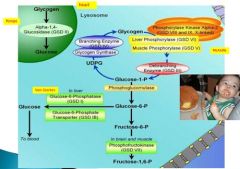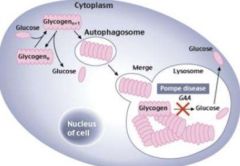![]()
![]()
![]()
Use LEFT and RIGHT arrow keys to navigate between flashcards;
Use UP and DOWN arrow keys to flip the card;
H to show hint;
A reads text to speech;
38 Cards in this Set
- Front
- Back
|
General facts on autosomal dominant disorders
|
-each generation affected (50% chance of passing it on)
-M=F -less severe, presents later in life (b/c other good copy makes up for it) -non or incomplete penetrance -variable expressivity -new mutations common |
|
|
Marfan's Syndrome
|
-Autosomal Dominant
-Single gene FBN1, fibrillin protein -Pigeon chest, long limbs -Sublexed lens, mitral valve prolapse -Aortic aneurysm/rupture -exhibits Pleiotropy (one genotype, many phenotypes) |
|
|
Ehlers-Danlos
|
-Autosomal Dominant/Autosomal Recessive subtype
-Ineffective collagen synthesis -Hyperextensible skin, hypermobile joints, aortic dissection -Lysyl Hydroxylase deficiency interfers with collagen cross-links (autosomal recessive) -exhibits Genetic Heterogeneity (6 variant genotypes, same disease) |
|
|
Familial hypercholesterolemia
|
-Autosomal Dominant
-Most common mendelian disorder -Mutation in the LDL receptor gene; up 5-fold increase in cholesterol (higher in homozygotes) -Xanthomas (lipid filled macrophages on skin, esp on achilles) -Premature atherosclerosis and MI (by age 20) -Statins inhibit HMG-CoA Reductase |
|
|
Neurofibromatosis type 1
|
-Autosomal Dominant
-Variable expressivity/multiple phenotypes -Optic gliomas, neurofibromas, lisch nodlues, disfigurement |
|
|
General facts on autosomal recessive disorders
|
-often skips generations, M=F
-apparent at birth or early childhood -very severe disorders -complete penetrance -if both parents heterozygous, children have 25% chance of acquiring disorder -may result from consanguineous matings -if common w/in population, probably balanced polymorphism |
|
|
Cystic fibrosis
|
-Autosomal recessive
-Most common lethal recessive genetic disease -Defective CFTR protein; regulates teh flow of salt and fluids across the cell membrane -Main mutation; Delta F508 mutation -exhibits Modifier Genes, which affect severity of disease; mannose-binding lectin confers a 3x risk of end stage lung disease |
|
|
Galactosemia
|
-Autosomal Recessive
-Mild:lack galactokinase->increased blood galactose, cataracts -Severe(more common):lack galactose-1-phsophate uridyl transferase (GALT) ->accumulation of toxic substance (galactitol) causes damage -Initial vomiting and diarrhea after milk -irreversible brain damage, cataracts, jaundice and hepatomegaly |
|
|
Phenylketonuria (PKU)
|
-Autosomal Recessive
-defective phenylalanine hydroxylase(convertes phenylalanine to tyrosine) -born normal->elevated phenylalanine in blood -> brain->mental retardation -pale (need tyrosine to make melanin) -mousy/musty body odor -need to ID early & remove phenylalanine in diet during pregnancy/brain development |
|
|
General facts about lysosomal storage diseases
|
-all are autosomal recessive (except Hunter''s disease, which is X-linked)
-defects of catabolism (mainly w/lipid degradation-therefore think CNS effects) -accumulations that progress over time -affects various organs (CNS, liver, spleen) -variable severity even w/in same disease -diseases w/hyphen in name have cherry-red spot on macula (Tay-Sachs & Niemann-Pick) |
|
|
Tay-Sach's Disease
|
-Autosomal Recessive
-Deficiency of hexosaminidase A w/accumulation of GM2 gangliosides (ganglion so think brain!) -Motor deterioration, mental retardation, cherry red spot on macula->blindness. Lethal -Ashkenazi jews |
|
|
Gaucher's disease
|
-Autosomal Recessive
-Deficiency of lysosomal glucocerBROsidase -> glucocerbroside accumulation -Ranges from lethal perinatal to asymptomatic form -Type I (chronic nonneuropathic); bone disease and absence of primary CNS disease -Enzyme replacement therapy or substrate inhibitors -Gaucher's cells="wrinkled tissue paper" cytoplasm |
|
|
Niemann-Pick disease
|
-Autosomal Recessive
-Deficiency of sphingomyelinase w/accumulation of sphingomyelin -Neurodegeneration, hepatosplenomegaly, cherry red spot on macula->blindness, foam cells. Lethal -Type A: severe neurological deterioration -Type C; Defect in lipid transport -> increased cellular cholesterol -> axia, vertical gaze palsy, dysarthria, dystonia, psycomotor regression |
|
|
(Mucopolysaccharidoses I) MPSI - Hurler
|
-Autosomal Recessive
-Deficiency in iduronidase -Coarse facial features and die due to early MI (coronary artery disease) -Corneal clouding |
|
|
(Mucopolysaccharidoses II) MPSII - Hunter
|
-X-linked (milder)
-Deficiency in sulfatase -Coarse facial features and die due to early MI (coronary artery disease) -No corneal clouding |
|
|
Glycogen Storage Disease
|

Von Gierke (Type I)
McArdle (Type V) Pompe (Type II) |
|
|
Von Gierke (Type I)
|
-Autosomal Recessive
-Glucose-6-Phosphatase Deficiency (G6PD) -Hypoglycemia, hepatomegaly |
|
|
McArdle (Type V)
|
-Autosomal Recessive
-Muscle Phosphorylase Deficiency -Skeletal muscle cramps on exercising |
|
|
Pompe (Type II)
|

-Autosomal Recessive
-Lysosomal Acid Maltase/Glucosidase Deficiency -Cardiomegaly, cardiac failure , floppy baby -Lysosomal storage disease as well as glycogen storage disease (pic) |
|
|
General Facts about Trinucleotide Repeat Disorders
|
-Anticipation=effects more severe w/each generation
-Gene methylation is the common cellular mechanism -> gene silencing |
|
|
Fragile X syndrome
|
-CGG repeats, X chromosome; loss of function
-Anticipation; repeats increase during oogenesis -Macro-orchidism, long face, everted ears -Mental retardation; FMR1 (family mental retardation) gene -X-linked (hits males harder but can also affect females mildly; males can also be "carriers") |
|
|
Huntington's disease
|
-Autosomal Dominant
-CAG repeats, chromosome 4, toxic gain of function -CNS: chorea, depression, dementia -Does not manifest until adulthood |
|
|
Down's Syndrome
|
-Trisomy 21
-Advanced maternal age -Mental retardation -Congenital heart diseas -Small bowel atresia, Hirschsprung disease -Leukemias and early Alzheimer's |
|
|
DiGeorge
|
-22q11.2 deletion
-Congenital heart disease -Cleft palate -Thymic and parathyroid hypoplasia -> impaired T-cell immunity and hypocalcemia |
|
|
Klinefelter Syndrome
|
-47XXY
-Male hypogonadism; azoospermia, Leydig cell hyperplasia -Nondisjunction during meiosis -Advanced maternal age |
|
|
Turner Syndrome
|
-45X
-Primary hypogonadism, primary amenorrhea -Short stature (deletion of SHOX gene) -Hypothyroidism, horseshoe kidneys |
|
|
Mitochondiral Mutations
|
-Genes encode for oxidative phosphorylation enzymes
-Skeletal muscle, heart and brain are most affected -Maternal inheritance (only daughters can transmit) -Leber Hereditary Optic Neuropathy - neurodegenerative disease that causes progressive blindess |
|
|
Prader-Willi
|
-Maternal imprinting (dad's gene silent)
-Mental retardation, hypogonadism, and obesity |
|
|
Angelman
|
-Paternal imprinting (mom's gene silent)
-Sever mental retardation, ataxia, inappropriate laughter, seizure -"Happy puppet syndrome) |
|
|
Malformation
|
-intrinsic disturbance in morphogenesis, heritable
ex. Holoprosencephaly and Cyclopia |
|
|
Disruption
|
-extrinsic disturbance in morphogenesis, secondary destruction or previously normally developed organ, not heritable
ex. Amniotic bands |
|
|
Deformation
|
-extrinsic disturbance in development, compression of fetus due to abnormal biochemical forces leading to structural abnormalities
ex. Prune belly (congenital absence of abdominal muscles; due to pressure a dilated bladder puts on the abdominal wall). |
|
|
Teratogens and their effects
|
Fetal Warfarin Syndrome; skeletal malformations
Thalidomide; limb reduction Fetal Valproate Syndrome; brain and vertebral malformations 13-cis-retinoic acid; cleft lip Diabetes; fetal macrosomia -> heart and neural tube defects |
|
|
Small for Gestational Age; causes
|
Fetal; chromosomal abnormalities/congenital malformations, TORCH. Symmetric growth retardation, all organs equally small
Placental; placenta previa (low implantation), abruption (detachment), infarction. Asymmetric growth, head spared relative to visceral organs. Maternal; pre-eclampsia, drug, alcoholm malnutrition, cigarettes |
|
|
Complications with prematurity
|
-Necrotizing enterocolitis - peritonitits, sepsis, stricture, short-gut and poor neurodevelopment
-Intraventricular hemorrhage (IVH) - obstructive hydrocephalus and periventricular leukomalacia -Retinopathy - retrolental fibroplasia -Patent ductus - due to pulmonary hypertension -Hyaline membranes - lack of surfactant, thick pink membranes -Bronchoplumonary dysplasia- interstitial fibrosis, simplified alveoli, dysmorphic capillaries |
|
|
SIDS
|
-Delayed development of arousal center (arcuate nucleus)
-Blunted arousal, breathing and heart rate response in hypoxia, hypercarbia and hyperthermia during sleep -Genetic defects in serotonergic signaling and autonomic innervation |
|
|
TORCH
|
-Toxoplasma; chorioretinitis, calcifications, hepatosplenomegaly
-Other (syphilis); notched teeth, saddle nose, osteochondritis, cataracts -Rubella; cataracts and deafness -CMV -Herpes; necrotizing encephalitits, skin ulcers, skin slough |
|
|
Hydrops fetalis
|
-Immune; RH incompatibility; Indirect Coomb's test (test mom for free antibodies), Direct Coomb's test (test babies RBCs for attached antibodies)
-Nonimmune; chromosomal anomalies (Turner's), infection (Parvo), severe anemia (Thalassemia), and neoplasms (sacrococcygeal teratoma) |

